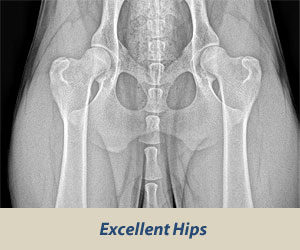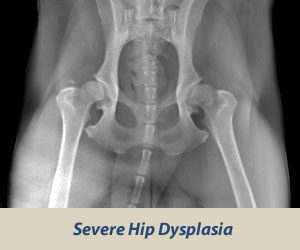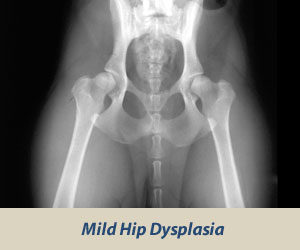Hip Dysplasia - Genetic & Environmental Prevention Strategies
- Ca' Rigada

- Jul 10, 2020
- 5 min read
Updated: Jul 14, 2020
Canine hip dysplasia (CHD, hereafter HD) "is a developmental orthopedic disease marked by hip laxity and disconformity that leads to hip osteoarthritis (OA) during and after maturity".(1). It can also be painful and debilitating to a dog's quality of life, and so it has already been many generations since the Verein Deustch-Drahthaar breed authority mandated the breeding of dogs that are, at a minimum, free of HD. Part of this process includes differentiation of non-dysplastic individuals into higher or lower "grades" of hips based on radiographic evidence of any laxity (i.e., looseness of the joint), the joint's structure (i.e., malformation, insufficient coverage of the femoral head by the acetabulum), remodeling (i.e., creation of structural changes such as development of bone spur osteophytes from wear and tear), as well as other indicators.

For breeds with sufficient population size and genetic diversity, these efforts seem to help reduce incidence of the disease in future generations(2) (although there have also been programs that appear to have had less than ideal results(3)). Nevertheless, individuals exhibiting the disease still occur: genetic research estimates that heritability of HD varies across breeds, and may range anywhere between .1-.68.(4) This means that genetics may explain a proportion (10-68%) of the variation of incidence of HD seen in the population, but does not determine all of it - and by some estimates, alarmingly not much at all. (Higher estimates are associated with PennHIP, which uses distraction index (DI) scores that objectively quantify hip laxity - or "looseness" in the hip joint.) As genetic screening methods are not yet advanced enough to identify what combinations of genes may produce dysplastic offspring (and as a further complication the genes associated with HD that have been identified vary from breed to breed), the phenotype of a dogs' relatives - especially grandparents, parents, siblings, half-siblings, and progeny - remain the best indicators of potential for HD. As such, the status of relatives should be reviewed by prospective puppy owners and breeders, and this is why hip scores are typically available on the ahnentafels - or pedigrees - of Deutsch Drahthaar.

The pedigree of Lux IV vom Böckenhagen, son of Eike della Ca' Rigada, and grandson of Nonatula Pan II and Nonatula Vroni II.
For this reason, we must start with good genetics but also look beyond them to secure the best hip quality outcomes for our dogs. Drahthaar and other breeders continue to leverage additional practices to reduce the likelihood of HD in puppies after birth. A critical time period is while the neonates are with the breeder, who can take certain steps to create an environment inimical to HD. This responsibility is then picked up by owners who typically take home their puppies around 8-10 weeks, as HD seems to develop during the rapid growth period of the first 6-7 months of a dog's life. Some indications that a dog will develop hip dysplasia are already quite evident before the first year is up. For example, one study demonstrated that young Labrador Retrievers with high (>0.7) distraction index scores have a high probability of developing hip osteoarthritis.(5) Actually, some HD and OA symptoms may even be visible as early as several weeks after birth, such as wear and tear type tissue damage.(6) Because HD may still be developing throughout the first year, radiographs to screen breeding dogs are typically only taken after a dog is at least 12-24 months of age. Specific positioning is required that often necessitates dogs are under anesthesia to maximize their comfort and the image quality of the resulting picture.
Excerpted from the Orthopedic Foundation for Animals: https://www.ofa.org/diseases/hip-dysplasia
See also PennHIP testing, which uses distraction index scores: https://antechimagingservices.com/antechweb/pennhip
Traction in the whelping box
This is perhaps the least well-known or researched potential factor. Hip dysplasia seems to begin with joint laxity, not just in canines but in other animals as well as humans. Dislocation or stress on the growing joint due to improper positioning of the legs of newborns can contribute to the development of hip dysplasia and osteoarthritis. This has prompted the International Hip Dysplasia Institute to issue their position statement on proper swaddling of infants based on numerous studies(7), and it may also be the case that it is true for newborn dogs.(8) The Institute of Canine Biology is currently conducting a study on whether or not flooring that minimizes hyperextension of neonates and young puppies' legs can reduce hip laxity and damage to hip joint and tissues. Check out their progress here: https://www.facebook.com/groups/ICBHipDysplasiaProject/

Diet
The notion that nutrition and quantity of food impacts whether or not a dog develops HD has been known since at least the 1970s, and has become something of common knowledge among dog owners. Overfeeding of individuals who are genetically predisposed seems to maximize the expression of HD.(9) One study found that the severity of hip dysplasia and osteoarthritis in Labrador Retrievers was significantly reduced (by 25%) by limiting food intake, and later studies have confirmed and replicated these results.(10) When selecting a diet, it is important to choose an age-appropriate diet with supplementation only under the guidance of a qualified professional, in addition to preventing excessive consumption. Keep in mind that not every dog professional is equally knowledgeable or experienced in canine nutrition, so consult with a board certified veterinary nutritionist or other specifically qualified expert.

Age appropriate exercise and physical activity
Puppies growth plates are born open and still developing. For example, the hip joint actually consists of cartilage and soft tissues that have not yet developed into bone at birth. Until a dog has physically matured (a general but not infallible rule of thumb is the larger the dog and breed, the longer to physical maturity), owners should consider what kinds of activities and exercises are appropriate for their puppy. Physical maturity can take anywhere from a year to sixteen months (and some estimates even suggest two years plus depending on the breed and individual). Simple injuries in an adult dog can be catastrophic for a small puppy if damage is done to their developing growth plates, even resulting in malformed limbs. Repetitive exercises such a excessively long walks or runs, hard and slippery surfaces, un-cushioned landings, and other common-sense high-impact or force movements should be minimized. There are similar concerns about the ill effects of endurance cardiovascular training in young puppies. Puppies do not typically over do it themselves, and enjoy rambling walks with lots of smelling, so this is typically safe from an exercise prospective, and appropriate for drahthaar in particular to build skills for the future. But pushing it beyond what a breed might naturally do themselves may be harmful. Below are some resources that may assist:
(1) Breur, G.J. and Sargan, D.R., "Genetics of Canine Hip Dysplasia and Other Orthopaedic Traits" in A. Ruvinsky and J. Sampson eds. The Genetics of the Dog (New York: CABI Publishing, 2001), 268.
(2) Swenson, L., Audell, L., and Hedhammar, A., "Pravalence and inheritance of and selection for hip dysplasia in seven breeds of dogs in Sweden and benefit:cost analysis of a screening and control program" Journal of the American Veterinary Medical Association (1997) 210: 207-214.
(3) Leppanen, M. and Saloniemi, H., "Controlling canine hip dysplasia in Finland", Preventive Veterinary Medicine (1999) 42: 121-131. See also Kaneene, J.B., Mostosky, U.V., and Padget, G.A. "Retrospective cohort study of the changes in hip joint phenotype of dogs in the United States" Journal of the American Veterinary Medical Association (1997) 211: 1542-1544.
(4) Breur and Sargan, 269.
(5) Lust, G., Williams, A.J., Burton-Wurster, N., Pijanowski, G.J., Beck, K.A., Rubin, G. and Smith, G.K., "Joint laxity and its association with hip dysplasia in Labrador Retrievers" American Journal of Veterinary Research 54: 1990-1999.
(6) Riser, W.H., "Hip dysplasia" in Newton, C.D. and Nunamker, D.M. eds., Textbook of Small Animal Orthopedics (1985), Chp. 83.
(9) Breur and Sargan, 275.
(10) Kealy et al., 1992, 1997. See also Smith, GK, ER Paster, MY Powers, DF Lawler, DN Biery, FS Shofer, PJ McKellvie & RD Kealy. 2006. Lifelong diet restriction and radiographic evidence of osteoarthritis of the hip joint in dogs. Journal of the American Veterinary Medical Association 229: 690-693.









Comments